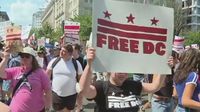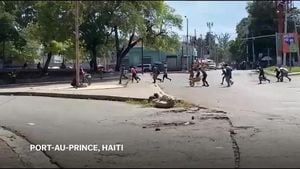On September 6, 2025, the streets of Washington, D.C. pulsed with the footsteps and shouts of thousands of protesters, their banners and voices unified in a single, urgent demand: end the federal government’s takeover of the city’s police force. The demonstration, part of the broader “We Are All D.C.” and “Free DC” movements, marked a dramatic escalation in the ongoing battle over the autonomy of the nation’s capital and the reach of federal power under President Donald Trump’s administration.
The roots of this mass mobilization stretch back to August 11, when President Trump declared a citywide crime emergency and ordered more than 2,000 National Guard troops to patrol Washington’s streets. According to Morocco World News, the heavy federal crackdown triggered outrage among residents and activists, who saw the influx of troops as an affront to local self-governance and a harbinger of creeping authoritarianism. Protesters, some waving Palestinian flags and others brandishing signs that read “end the military occupation of DC,” marched through the city, their chants echoing off government buildings and monuments.
“I’m here to protest the occupation of DC,” one demonstrator told Reuters. “We’re opposing the authoritarian regime, and we need to get the federal police and the National Guard off our streets.” The sentiment was echoed by Samantha Millar, a longtime D.C. resident and active member of the movement. “DC has been through so much as a city – the people here are used to fighting for rights. The national guard has been deployed two times just in the seven or so years that I’ve been here,” she told Morocco World News. “That’s not to say this isn’t a clear sign of an authoritarian power grab, but it is to say that I have immense pride, faith and respect for my DC friends and neighbors. We won’t take this sitting down.”
The protest was not a spontaneous outburst but rather the culmination of weeks of mounting frustration. According to Xinhua, thousands gathered in the heart of the capital on September 6 to make their discontent visible and impossible to ignore. Their anger was fueled by more than just the presence of federal troops; it was a response to a series of aggressive interventions by the Trump administration in Democratic-led cities across the country.
For many, the deployment of the National Guard and federalization of the Metropolitan Police Department represented a breaking point. The symbolism was potent: the nation’s capital, long a site of protest and political expression, had become the stage for a struggle over the very meaning of democracy and local control. As CNN reported, the demonstration coincided with President Trump’s signing of an executive order to rename the Department of Defense as the “Department of War,” a move he claimed was more “appropriate given the state of the world.” The timing was not lost on either side of the political divide, with critics arguing that the rebranding signaled a troubling embrace of militarism and a willingness to use force against domestic dissent.
In the days leading up to the protest, the Trump administration had made no secret of its intention to double down on law-and-order policies. According to Morocco World News, the president threatened to send National Guard troops to Chicago next, suggesting that the federal government was prepared to intervene in any city it deemed unruly. This rhetoric, coupled with the ongoing crackdown in Washington, stoked fears that a “dangerous authoritarian playbook” was unfolding at what Amnesty International called “shocking speed.”
The grievances aired by protesters on September 6 were varied but interconnected. Some participants called for an end to the illegal detainment and deportation of immigrants by Immigration and Customs Enforcement (ICE), while others condemned the U.S. government’s support for Israel, which they accused of committing genocide. The demonstration also echoed the “No Kings” protests of June, which had denounced what activists described as “fascist policies” and the intimidation of citizens through displays of military might.
Opposition to the federal crackdown was not confined to the streets. In Congress, Democratic lawmakers voiced strong resistance to President Trump’s actions. Washington Mayor Muriel Bowser, who initially fought the administration’s policies before ultimately conceding, described the situation as “unsettling and unprecedented.” Her words captured the anxiety felt by many in the city, where memories of past confrontations with federal authority run deep.
“The national guard has been deployed two times just in the seven or so years that I’ve been here,” Samantha Millar noted, highlighting the persistence of federal intervention in local affairs. Yet for many, the current situation felt different—more acute, more threatening, and more emblematic of broader trends toward centralized power and diminished civil liberties.
Human rights organizations quickly sounded the alarm. Amnesty International, in particular, warned that the deployment of military force against American citizens was highly taboo and set a dangerous precedent. The group’s statement described the events as evidence of “a dangerous authoritarian playbook unfolding at shocking speed.” The choice of words reflected a deep unease about the direction of the country and the potential erosion of constitutional norms.
Despite these warnings, some politicians aligned with President Trump defended the federal intervention, arguing that the presence of the National Guard was necessary to restore order and address rising crime. However, even among the troops themselves, there was a sense of unease. In an interview with CNN, some National Guard soldiers admitted they felt “purposeless in DC” and that morale was “falling fast.” The disconnect between the official rationale and the lived experience of those on the ground only added to the sense of crisis.
As the sun set over Washington on September 6, the protesters dispersed, but their message lingered in the humid air. The “We Are All D.C.” movement had made its mark, drawing national and international attention to the struggle for local autonomy and the dangers of unchecked federal power. Whether the demonstration will lead to meaningful change remains to be seen, but for now, the city’s residents have sent a clear signal: they are not willing to cede control of their streets—or their future—without a fight.
The events of early September 2025 have left Washington, D.C. at a crossroads, with the balance between security and self-determination hanging in the balance. The outcome of this struggle will likely reverberate far beyond the city’s borders, shaping the contours of American democracy for years to come.




